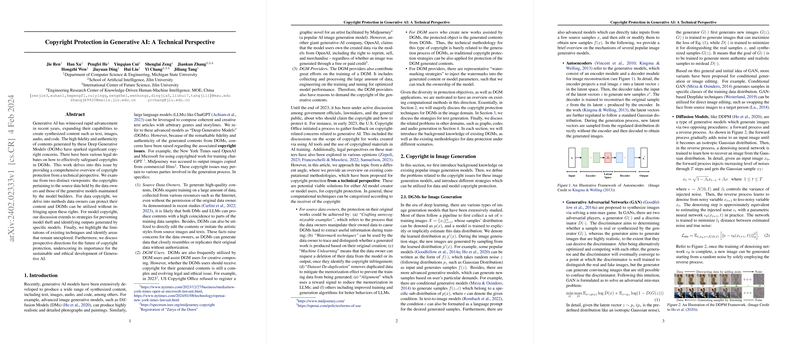Comprehensive Review on Copyright Protection in Generative AI Across Domains
Introduction to Copyright Concerns in Generative AI
The rapid advancement and widespread application of Generative Artificial Intelligence (Generative AI), encompassing technologies from LLMs to sophisticated image and audio synthesis models, have introduced remarkable capabilities in creating highly authentic and customizable content. However, the authenticity and fidelity of content generated by these Deep Generative Models (DGMs) have raised significant copyright concerns. For instance, recent developments have seen lawsuits filed against major AI entities for allegedly utilizing copyrighted content without permission to train their models. This highlights a growing imperative to explore and enforce copyright protection mechanisms in the field of Generative AI across various domains.
Approaches to Copyright Protection
Data Copyright Protection
Efforts to safeguard data copyright focus primarily on preventing the unauthorized replication of protected content by generative models. Methods like data deduplication, enhanced training algorithms, alignment strategies, and machine unlearning have been proposed, predominately catered to specific model architectures or learning algorithms. While effective to an extent, these approaches often lack comprehensiveness across different DGM architectures, emphasizing the need for versatile methods capable of providing robust protection across the gamut of generative models.
Model Copyright Protection
Model copyright protection strives to secure the intellectual property rights of model creators against unauthorized usage or replication. Innovations in this field include watermarking techniques (parameter-based, image-based, and triggered-based watermarking) and strategies to detect unauthorized model duplication. While watermarking has emerged as a prevalent method for asserting copyright claims, it often encounters challenges related to robustness against evasion tactics and the balance between ensuring copyright protection and maintaining model performance.
Challenges and Future Directions
The landscape of copyright protection in Generative AI is fraught with challenges.
- Comprehensiveness: Many existing data protection methods are tailored to specific models and might not extend protection against different or future models.
- Robustness and Performance Trade-off: Enhancing the robustness of watermarking and other copyright protection techniques without compromising the model's performance remains a significant challenge.
- Flexibility and Efficiency: Developing flexible and efficient methods capable of protecting a variety of DGMs without extensive customization is crucial for broader applicability.
- Advanced Detection Methods: There is a growing need for sophisticated detection methods that can promptly identify copyright infringement, especially in real-time scenarios.
- Expansion to Diverse Domains: Beyond text and image generation, extending copyright protection mechanisms to domains like audio, code, and multi-modal generation is becoming increasingly essential.
Conclusion
As Generative AI continues to evolve, so too does the complexity of copyright protection. Bridging the gap between advanced AI capabilities and copyright enforcement requires a concerted effort from both technological and legal perspectives. By fostering innovation in comprehensive, robust, and flexible copyright protection strategies, we can ensure a future where Generative AI thrives without compromising the rights of copyright holders.
